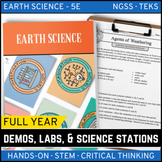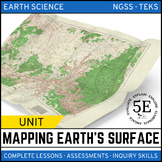Mapping Earth's Surface - Demos, Labs, and Science Stations
- Zip
What educators are saying
Also included in
- Working in the lab and being engaged in science experiments is the most exciting part of science. The following Earth Science Demo, Labs, and Science Stations Bundle give your students the opportunity to investigate, explore and learn the life science topics being studied.Topics for this bundle incPrice $135.50Original Price $169.40Save $33.90
- Mapping Earth's Surface is an Earth Science unit that includes engaging resources for your students to master topics. The unit follows this suggested pacing guide: Day 1: Teacher Demo - An Imaginary GridSection 1: Mapping Earth's Surface PowerPoint, Notes, and Interactive Notebook (Traditional or DPrice $35.94Original Price $44.92Save $8.98
Description
Working in the lab and being engaged in science experiments is the most exciting part of science. The following Mapping Earth’s Surface Demo, Labs, and Science Stations give your students the opportunity to investigate, explore and learn the science topic being studied.
Mapping Earth's Surface Demo, Labs, and Science Stations Includes:
1. SCIENCE STATION SIGNAGE for all 7 stations is provided in color and in black and white (see preview) and all student answer sheets have icons that correspond with each station for ease of use.
2. DEMONSTRATION (teacher-led) allows teachers to invite scientific discussions and can help uncover misconceptions and, most importantly, lead to heightened curiosity and interest in the topic being studied.
3. GUIDED INQUIRY LAB which is a traditional lab that allows students to perform an investigation in order to solve a problem. Students will hypothesize, collect and analyze data and communicate their results.
4. TEACHER GUIDES to DEMOS & SCIENCE STATIONS help get you started and give you background information to make your science lessons engaging.
5. 7 SCIENCE STATIONS which are designated locations in the classroom with activities that challenge students to extend their knowledge and elaborate on their science skills by working independently of the teacher in small groups or pairs. Stations included are:
- INFORMATION STATION - Group members will read an interesting and relevant science passage then complete a task to help increase science literacy and deepen their understanding of the science concept.
- OBSERVATION STATION - Group members will have images, illustrations, or actual samples at this station that show applications or processes of the science topic. Using what they’ve learned, they will need to apply their observation skills to complete the questions attached to each.
- CALCULATION STATION - Group members use their math skills to complete the station challenge. Skills may include graphing, analyzing data, using models, measurement, and calculating formulas or word problems.
- INVESTIGATION STATION - Group members will work with one another to explore the concept through hands-on activities so they may practice specific inquiry process skills as they learn.
- COMMUNICATION STATION - There are three different options for this station: interviews, video, group essay. Depending on the option you choose, group members will communicate what they know by answering questions in creative ways.
- CREATION STATION - Group members will work together to solve a STEM (Science, Technology, Engineering, Math) challenge by creating models or designs that demonstrate their understanding of the science topic being taught. IMAGINATION STATION - This station makes science concepts relevant for students by asking them to imagine scenarios that will bring about discussion and critical thinking.
6. INQUIRY PROCESS SKILLS CHECKLIST is provided with each set to show teachers and administrators the inquiry skills used by students in each activity. These skills include, but are not limited to, communicating, creating models, inferring, classifying, identifying variables, measuring, observing, predicting, gathering and organizing data, comparing and contrasting, interpreting data, and manipulating materials.
Topics Included for Mapping Earth’s Surface:
- Exploring Earth’s Surface
- Models of Earth
- Maps & Computers
Mapping Earth’s Surface Demo, Lab & Science Stations will showcase each student’s ability to:
- Identify main types of landforms
- Explain the topography of an area
- Explain how maps and globes represent Earth’s surface
- Identify latitude and longitude as reference lines
- Explain how elevation, relief, and slope are shown on topographic maps through the use of contour lines.
************************************************************
Copyright © Nitty Gritty Science, LLC. All rights reserved by author Dr. Erica Colón. This product is to be used by the original downloader only. Copying for more than one teacher, classroom, department, school, or school system is prohibited. This product may not be distributed or displayed digitally for public view. Failure to comply is a copyright infringement and a violation of the Digital Millennium Copyright Act (DMCA). Clipart and elements found in this PDF are copyrighted and cannot be extracted and used outside of this file without permission or license. Intended for classroom and personal use ONLY.




